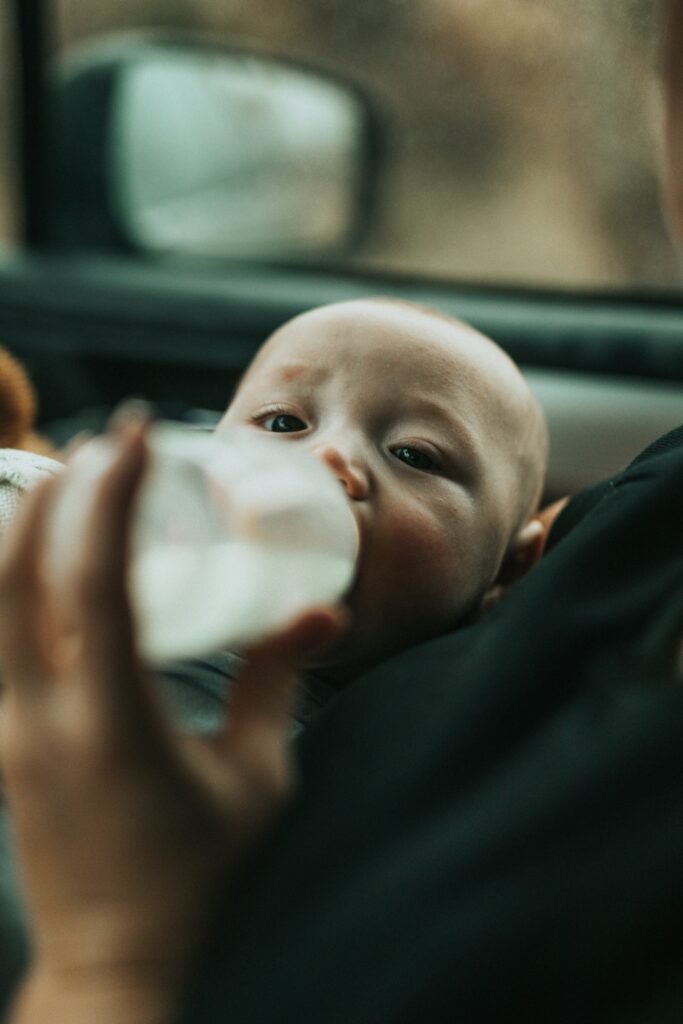When a baby is allergic to milk, it’s typically due to a cow’s milk protein allergy (CMPA), which means their immune system mistakenly identifies the proteins in milk (like casein and whey) as harmful and triggers an allergic reaction. This type of allergy is more common in infants and can cause a range of symptoms. I’ll break down the symptoms in more detail, categorized by system in the body:
1. Skin Reactions
Skin symptoms are common in babies with milk allergies. These can include:
- Eczema (atopic dermatitis): Red, itchy, and inflamed patches of skin, often found on the cheeks, arms, or legs.
- Hives (urticaria): Raised, red, itchy bumps or welts on the skin. They can appear soon after consuming milk or formula.
- Swelling (Angioedema): The lips, face, or eyes may become swollen. In more severe cases, swelling of the throat can occur, making it difficult for the baby to breathe (this is a medical emergency).
2. Digestive Issues
Digestive problems are very common with a milk allergy and can be quite distressing for babies. Some common digestive symptoms include:
- Vomiting: This can happen immediately after or a few hours after consuming milk. It may occur in response to the allergic reaction.
- Diarrhea: Milk allergies can cause loose, watery stools, sometimes with visible blood or mucus. This is a sign of inflammation in the gut.
- Blood in stool: Some babies may pass stool that is streaked with blood, which can indicate irritation or even inflammation in the intestines caused by the allergy.
- Abdominal pain: Babies may experience cramping or discomfort in the belly, leading to fussiness or crying, especially after drinking milk.
3. Breathing Issues
An allergic reaction to milk can affect the respiratory system, leading to:
- Wheezing: A high-pitched sound when breathing, often associated with asthma-like symptoms.
- Coughing: A persistent cough may develop, especially after consuming milk.
- Difficulty breathing: In severe cases, anaphylaxis (a life-threatening allergic reaction) can cause the throat to swell, leading to trouble breathing. If this happens, immediate medical attention is needed.
4. Colicky Behavior (Crying/Fussiness)
Babies with milk allergies often experience colic, which means excessive crying, particularly after feedings. This is due to the discomfort caused by the allergic reaction in their digestive system. The crying may occur for several hours each day, and the baby may seem inconsolable.
5. Behavioral Changes
- Irritability: Babies may be unusually fussy or irritable, particularly after consuming milk.
- Poor feeding: Some babies with milk allergies might refuse to drink milk or seem disinterested in feeding. This is often because they associate the feeding with discomfort.
6. Anaphylaxis (Severe Reaction)
Anaphylaxis is a rare but serious allergic reaction that can occur quickly. Symptoms include:
- Swelling of the lips, tongue, or throat, making it difficult for the baby to breathe or swallow.
- Hives or a rash spreading rapidly over the body.
- Difficulty breathing, wheezing, or a bluish color around the lips or face.
- Loss of consciousness or shock (this requires immediate medical attention).
How is Milk Allergy Diagnosed?
If you notice symptoms like those above, it’s essential to talk to your pediatrician. Here’s how the diagnosis might proceed:
- History and Symptoms: The doctor will ask about the baby’s feeding habits, any symptoms you’ve observed, and whether there’s a family history of food allergies.
- Physical Exam: Your doctor will examine your baby for visible signs of the allergy, like rashes or swelling.
- Skin Prick Test: A small amount of milk protein is placed on the skin, and a tiny needle pricks the skin. If the baby is allergic, a small raised bump will appear.
- Blood Test: A blood test may measure specific antibodies (IgE) to see if the body is reacting to milk proteins.
- Elimination Diet: The doctor may recommend removing all sources of milk (including formula if your baby is bottle-fed) from the baby’s diet to see if symptoms improve.
Treatment Options
- Avoidance of Milk: The main treatment is to eliminate milk (and milk-based formula) from the baby’s diet. If you’re breastfeeding, you may need to remove milk from your own diet.
- Hydrolyzed Formula: For babies who need formula, a special type called hydrolyzed formula may be recommended. These formulas have milk proteins that are broken down into smaller parts to reduce the risk of an allergic reaction.
- Epinephrine: In cases of severe allergic reactions (anaphylaxis), an epinephrine injection is given to reverse the symptoms. This is typically prescribed for babies at high risk of severe reactions.
- Antihistamines: These can help manage mild allergic reactions like hives or skin rashes, but they are not a solution for more serious reactions.
Can Milk Allergy Be Outgrown?
Many babies will outgrow milk allergies by the time they are 3 to 5 years old. However, some children may continue to have milk allergies into their teenage years or adulthood.
If you suspect a milk allergy, it’s crucial to work with a healthcare provider who can guide you through the proper steps for diagnosis and treatment.
Is there anything in particular you’ve noticed that makes you suspect a milk allergy in your baby?

